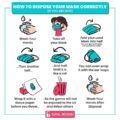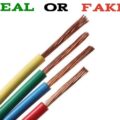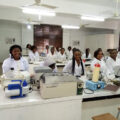Copper Fit mask comes in different shades and sizes , it is designed to help bring you peace of mind in the midst of the world deadliest pandemic. The non-slip design of most of these masks provides 30 UPF protection in a breathable thermal-regulating Smart Technology fabric that helps keep you cool and dry.
Copper-infused also mask to help reduce bacteria that cause odors. According to WHO Masks should be used as part of a comprehensive strategy of measures to suppress transmission and save lives; the use of a mask alone is not sufficient to provide an adequate level of protection against COVID-19.
How Do Copper Fitted Masks Work?
Knowledge of copper’s infection-killing abilities stretches back thousands of years. Its earliest use in medicine is believed to be recorded in the Smith Papyrus, an ancient Egyptian medical text.
According to Michael Schmidt, a professor of microbiology and immunology at the Medical University of South Carolina who studies the use of copper in health-care settings, people had observed that if they stored water in copper vessels, “members of their family had lesser chances of developing acute diarrheal diseases from bad water, and mortality, especially among infants and children, went way down,” Schmidt said. “Fast-forward to now, we understand how copper is inactivating microorganisms and it’s a pretty remarkable and straightforward mechanism.”
When bacteria come into contact with the metal and its alloys such as brass, the copper attracts electrons from the microbes, producing free radicals, or highly reactive, unstable molecules, that kill pathogens “very quickly and without mercy,” Schmidt said. Copper has an equally devastating effect on viruses, he noted, generating oxygen molecules that behave like “an exploding grenade.”
“The oxygen shrapnel first destroys the envelope” of the viruses, Schmidt said. “Then, additional oxygen radicals come in to destroy the viral RNA, and if the instruction set is not intact, you have no virus.”Studies have found that copper surfaces can limit the spread of bacteria such as E. coli and salmonella, as well as highly infectious viruses like norovirus. And research conducted during the pandemic has shown that it has the same effect on the coronavirus.
Those powerful antimicrobial properties have sparked the production of and consumer interest in masks containing the metal, which purport to offer protection against infectious particles. Although many of these claims may have some theoretical merit, experts are urging people to exercise caution until more data on efficacy can be gathered.
“They’re all the product of people’s ingenuity, but we don’t know whether they’re useful,” said William Schaffner, medical director of the National Foundation for Infectious Diseases.
Research has shown that copper-infused masks can quickly inactivate viruses that come into contact with the material. A 2010 study found that N95 respirators impregnated with copper effectively destroyed the flu virus on the surface of the mask without compromising filtration ability. The peer-reviewed study was conducted by researchers affiliated with Cupron Scientific, which is now selling reusable masks with copper.
Several of the scientists involved in developing Cupron’s antiviral mask technology have since released another paper, reporting that N95s and regular surgical masks with copper-oxide microparticles in their outside layers inactivated the novel coronavirus by more than 99.9 percent within one minute of contact. Those findings have not undergone peer review.
While the existing research is sound, “you and I are not interested in protecting masks from flu. We’re interested in protecting people,” Schaffner said.
Logically, he said, if the virus is inactivated on the surface of the mask, you are less likely to breathe it in and less likely to contaminate your hands if you touch your mask. “I love the logic,” he said. But, the question remains: “Does it really work in preventing illness, infection in people?”
There are several unknowns about copper masks that may affect their efficacy. Cloth and surgical masks don’t always fit snugly, creating gaps where air can flow around the covering instead of being filtered through it, said Linsey Marr, a Virginia Tech professor who studies airborne transmission of infectious diseases. Adding copper may also make a mask stiffer, causing it to conform less well to your face, or compromise the tightness of the material’s weave, Marr said.
“For the copper to work, the mask has to physically trap the virus in the first place,” she said. “The copper is not like a magnet for the virus.”
Experts say more studies are needed. “There are various layers of evidence,” said Monica Gandhi, a professor of medicine and an infectious-disease expert at the University of California at San Francisco. “We’re still sitting at the theoretical, totally makes sense layer of evidence.”
One possible next step would be conducting laboratory tests where the masks are placed on mannequins and infectious particles, in droplet and aerosol size, are sprayed at the coverings to see how many make it through, Gandhi said.
Still, if you find an affordable, tightly woven and well-fitted mask that has copper, experts say there probably isn’t any harm in using it. Just keep in mind that research has not yet shown whether the masks offer any more protection than multiple-layer cloth coverings or medical-grade masks recommended by public health officials.
“At this point in time, you use it with the same level of caution you would use all masks,” Schmidt said.






